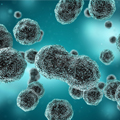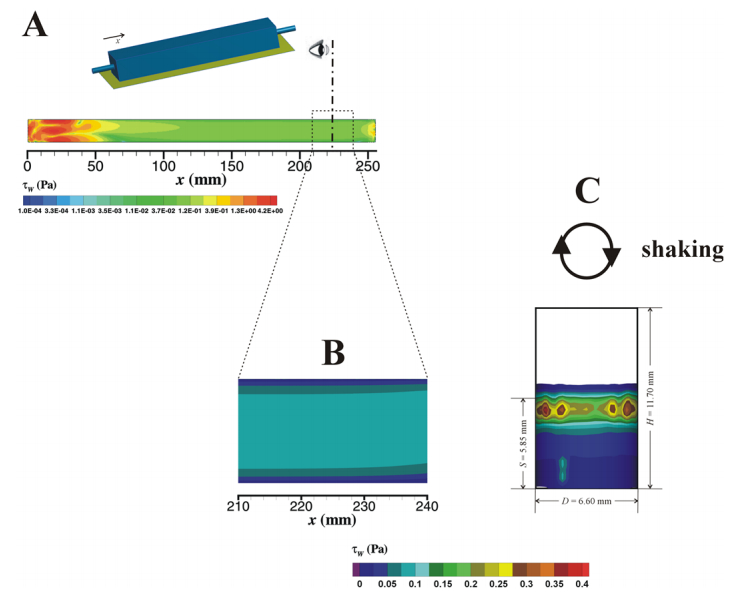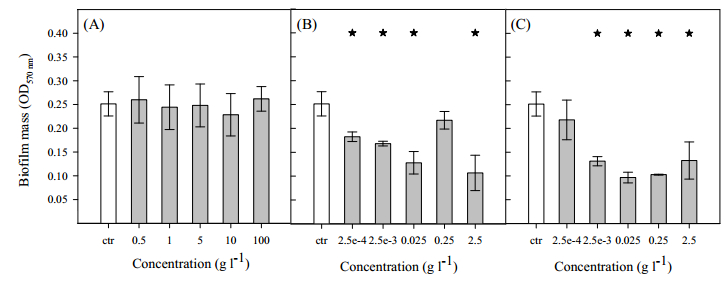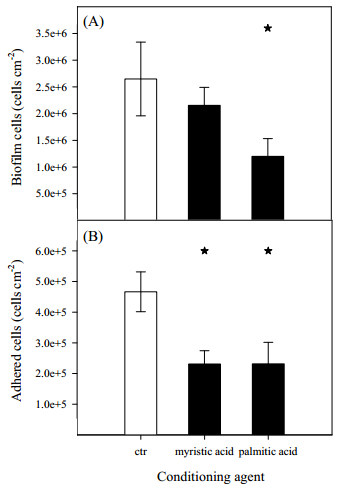Bacterial adhesion and biofilm formation on food processing surfaces pose major risks to human health. Non-efficient cleaning of equipment surfaces and piping can act as a conditioning layer that affects the development of a new biofilm post-disinfection. We have previously shown that surface conditioning with cell extracts could reduce biofilm formation. In the present work, we hypothesized that E. coli cell wall components could be implicated in this phenomena and therefore mannose, myristic acid and palmitic acid were tested as conditioning agents. To evaluate the effect of surface conditioning and flow topology on biofilm formation, assays were performed in agitated 96-well microtiter plates and in a parallel plate flow chamber (PPFC), both operated at the same average wall shear stress (0.07 Pa) as determined by computational fluid dynamics (CFD). It was observed that when the 96-well microtiter plate and the PPFC were used to form biofilms at the same shear stress, similar results were obtained. This shows that the referred hydrodynamic feature may be a good scale-up parameter from high-throughput platforms to larger scale flow cell systems as the PPFC used in this study. Mannose did not have any effect on E. coli biofilm formation, but myristic and palmitic acid inhibited biofilm development by decreasing cell adhesion (in about 50%). These results support the idea that in food processing equipment where biofilm formation is not critical below a certain threshold, bacterial lysis and adsorption of cell components to the surface may reduce biofilm buildup and extend the operational time.
1.
Introduction
In the evolutionary history of natural communities, ecological competition has justifiably been a significant force, which consists of exploitation and interference [1,2,3]. In consequence, there has been increasing studies for consumer-resource competitive models by dynamical systems theory [4,5,6,7]. Mathematically, Gopalsamy [8] developed the following resource-based competition model.
where x(t) represents the density of a logistically self-renewing resource at time t, z1(t) and z2(t) represent the densities at time t of two species which feed on this resource alone.
For a population individual, its whole life history generally includes two or more stages, particularly, mammals show two different stages of immaturity and maturity [9,10,11]. Moreover, it takes some time from birth to adulthood which is considered as the maturity time delay. Thus, the competition models and stage structure population models with constant maturity delays have been studied. For example, the two-species competition model and stage-structured single population model established in [12,13] respectively have a constant maturity delay.
Later, people noticed the biological fact about the maturity time of Antarctic whales and seals around the Second World War. Subsequent to the introduction of factory ships and with it a depletion of the large whale population, there has been a substantial increase in krill for seals and whales. It was then noted that seals took 3 to 4 years to mature and small whales only took 5 years [14]. Hence, their maturation time varies with the number of krill available, which implies that the maturity time delay is state-dependent, not a constant.
Due to this, Aiello and Freedman [15] formulated the following stage-structured state-dependent delay model, in which the delay τ(z(t)) is a bounded increasing function of the total population z(t)=x(t)+y(t).
Subsequently, the stage-structured and competitive models with state-dependent delays were developed [16,17,18,19,20,21,22,23,24,25,26]. In 2017, Lv and Yuan [27] proposed the competitive model with state-dependent delays:
where the delays τ(zi(t)) are bounded increasing functions of the populations zi(t), i=1,2, respectively.
It is obvious that the above-mentioned models with state-dependent delays straight change the constant delays into the state-dependent delays, which is not appropriate to population modeling. Therefore, Wang, Liu and Wei [28] proposed the following new single population model with a state-dependent delay and a correction factor.
where the delay τ(z(t)) is a function of the total population z(t)=x(t)+y(t).
However, the aforementioned state-dependent delays are functions of populations, not resources. A worthwhile thought is how to reflect the direct relationship between the resources and maturity time? In view of the biological background above, the time varies with the resources available, that is, the species must spend enough time in the immature stage to accumulate a certain amount of food to reach maturity. To address the question raised above, we consider a stage-structured consumer-resource competition model with a state-dependent maturity time delay, in which the delay involves a correction term, 1−τ′(x)x′(t), related to resource changes.
The paper is organized as follows. In section 2, we formulate a resource-based competition model with a state-dependent maturity delay. In section 3, we study the well-posedness properties for the model and prove the existence and uniqueness of all equilibria. In section 4, we analyze the local stabilities of equilibria. In section 5, we discuss the global behaviors of the coexistence equilibrium. Finally, section 6 gives the conclusions of the paper.
2.
Model formulation
Based on model (1.1), we will formulate the competition model with a state-dependent maturity delay. For each i=1,2, let yi(t) and zi(t) be the densities at time t of the immature and mature consumer species, respectively. Let x(t) be the density at time t of a logistically self-renewing resource which is necessary for two consumer species. Motivated by [28,29,30,31], we introduce a threshold age τ(x(t)) to distinguish the immature and mature individuals, which depends on the density of the same resource. Suppose that ρi(t,a) is the population density of age a at time t, then the densities of yi(t) and zi(t), respectively, are given by
By virtue of [32,33], we have the following age structure partial differential equations to represent the development of the consumer species.
We suppose that y1(t) and y2(t) die at the constant rate γi (i=1,2). The parameters βi (i=1,2) represent the mature natural death and overcrowding rate for zi(t), respectively. The parameters μi (i=1,2) represent interspecific competition for zi(t), respectively.
Taking the derivatives of yi(t) and zi(t), respectively, and combining system (2.1), it then follows that
Note that the two primes refer to differentiation with respect to x and time t, respectively, namely, ˙τ(x(t))=dτ(x(t))/dt=τ′(x)x′(t).
Because of the finitude of individual life span, ρi(t,∞) is considered as zero. Assume that the immature consumers' functional response is Holling type I, that is, bix(t), then the term ρi(t,0)=bix(t)zi(t) represents the number of immature individuals born at time t. Therefore, for t≥˜τ=max{τ(x(t))}, we have
Consequently, we obtain the following stage-structured consumer-resource competition model with a state-dependent delay.
where r and K represent the growth rate of the resource and its carrying capacity, respectively. The parameters a1 and a2 represent the capture rate of z1 and z2, respectively. By [28], the inequality, 1−τ′(x)x′(t)>0, holds true, which implies that t−τ(x(t))) is a strictly increasing function in t. This shows that mature individuals become immature only by birth.
For system (2.2), there are the following basic hypotheses:
(A1) The constant parameters r, K, a1, a2, b1, b2, γ1, γ2, β1, β2, μ1, μ2 are all positive;
(A2) The state-dependent time delay τ(x) is a decreasing differentiable bounded function of the resource x, where τ′(x)≤0, and 0≤τm≤τ(x)≤τM with τ(+∞)=τm, τ(0)=τM.
To simplify system (2.2), we can readily scale off r and K by proper rescaling of t and x. Accordingly, system (2.2) becomes
In this paper, we will study the dynamics of system (2.3). The initial data for system (2.3) are
with
which represent the number of immature consumers who survived to time t=0.
3.
Preliminary results
In this section, we first study the well-posedness properties of the solution for system (2.3) and then prove the existence and uniqueness of all equilibria.
Theorem 3.1. Let Υ(t)≥0, Φ1(t)≥0 and Φ2(t)≥0 for −τM≤t≤0, then the solution (x(t),y1(t),z1(t),y2(t),z2(t)) of system (2.3) is nonnegative and uniformly ultimate bounded for all t≥0.
Proof. Consider the first equation in system (2.3).
with x(0)=Υ(0)≥0. Then
Suppose that there exists t>0 such that z1(t)=0. Let t∗=inf{t:t>0,z1(t)=0}, then
Since τ(x)>0, 1−τ′(x(t∗))x′(t∗)>0, t∗−τ(x(t∗))<t∗, it follows from the definition of t∗ that z1(t∗−τ(x(t∗)))>0, which implies that z′1(t∗)>0 and is a contradiction. Therefore, there does not exist t∗ and z1(t)>0 for all t>0.
Integrating the second equation of system (2.3), we have the following integral expression for y1(t).
It is easy to see that y1(t)≥0 by the nonnegativity x(t), z1(t) and τ(x). In a similar way, we can prove the nonnegativity of z2(t) and y2(t). Hence, the solution (x(t),y1(t),z1(t),y2(t),z2(t)) of system (2.3) is nonnegative. Especially, when Υ(0)>0,Ψ1(0)>0,Φ1(0)>0, the solution of system (2.3) is positive.
Now we prove uniform ultimate boundedness of the solution. Define the following Lyapunov functional.
Calculating the time derivative of V(t) along the solutions of system (2.3), we have
where γ=min{γ1,γ2}, M1, M2 and M3 are the maximum values of quadratic function (b1/a1+b2/a2)[(1+γ)x(t)−x2(t)], γz1(t)−β1z21(t) and γz2(t)−β2z22(t), respectively. Obviously, M1, M2 and M3 are positive. Thus, lim supt→∞V(t)≤(M1+M2+M3)/γ and the solution of system (3.1) is uniformly ultimate bounded. It then follows that the solution of system (2.3) is uniformly ultimate bounded.
Since variables y1(t) and y2(t) of system (2.3) are decoupled from the other equations, we study the following reduced system:
In the rest of this section, we will discuss the existence and patterns of equilibria (x,z1,z2) of system (3.1). The equilibria satisfy the following equations:
It is easy to see that system (3.1) has one trivial equilibrium E0=(0,0,0) and one semitrivial equilibrium E1=(1,0,0). And we obtain the following result for nontrivial equilibria.
Theorem 3.2. System (3.1) has exactly two semitrivial equilibria E2=(ˆx,^z1,0) and E3=(˜x,0,~z2). Assume that
Then there exists unique coexistence equilibrium E∗=(x∗,z∗1,z∗2).
Proof. There are three cases to prove the existence of nontrivial equilibria.
Case 1 If z2=0, then Eq (3.2) reduces to
The inequality, z1<b1/(a1b1+β1), is valid to make sure x=1−a1z1>0, y1=γ−11z1(b1−a1b1z1−β1z1)>0. Thus, we will investigate the existence and uniqueness of nontrivial equilibrium in Λ={z1∈R∣0<z1<b1/(a1b1+β1)}⊂R. Define f:¯Λ→R be a continuous mapping by
Clearly, f(0)=b1xe−γ1τ(1)>0, f(b1/(a1b1+β1))=b1β1/(a1b1+β1)[e−γ1τ(β1/(a1b1+β1))−1]<0, which implies that f(z1) has at least one positive zero point ^z1.
Note that f′(^z1)=−a1b1e−γ1τ(1−a1^z1)+a1b1γ1(1−a1^z1)e−γ1τ(1−a1^z1)τ′(1−a1^z1)−β1<0, it then follows that f(z1) has a unique positive root in the interval (0,b1/(a1b1+β1)). Hence, system (3.1) has a unique boundary equilibrium E2=(ˆx,^z1,0).
Case 2 If z1=0, then system (3.1) has a unique boundary equilibrium E3=(˜x,0,~z2) by similar arguments in the case 1.
Case 3 If z1≠0 and z2≠0, then the coexistence equilibrium E∗=(x∗,z∗1,z∗2) satisfies the following equations:
Solving Eq (3.4), we obtain that
In order to make sure the positivity of x∗, z∗1 and z∗2, we get
Now we prove the uniqueness of E∗. Suppose that f(x)=1−x−a1z1−a2z2, combining Eq (3.5), we have
where f1(x)=b1e−γ1τ(x)(a1β2−a2μ2)/(β1β2−μ1μ2), f2(x)=b2e−γ2τ(x)(a2β1−a1μ1)/(β1β2−μ1μ2).
Obviously, f(0)=1>0 and
which implies that f(x) has at least one positive zero point x∗.
It follows from f1(x∗)+f2(x∗)=1/x∗−1 that
If min{β1/μ1,μ2/β2}<a1/a2<max{β1/μ1,μ2/β2}, then f′(x∗)<0. Thus, f(x) has a unique positive root x∗ in the interval (0,1), and system (3.1) has a unique coexistence equilibrium E∗=(x∗,z∗1,z∗2). This completes the proof.
4.
Linearized stability of equilibria
In this section, the linearized stability of equilibria will be studied. We utilize the method proposed by Cooke [34] to linearize system (3.1).
Let ˜E=(˜x,~z1,~z2) be an arbitrary equilibrium. Then the linearization of system (3.1) is
where
The corresponding characteristic equation of system (4.1) is as follows:
For the extinction equilibrium E0=(0,0,0), it follows that A=1, A1=0, B1=0, C1=0, A2=0, B2=0, C2=0, then (λ−1)λ2=0, and λ=1>0 is one of these eigenvalues. Thus, we have the following result.
Theorem 4.1. The extinction equilibrium E0=(0,0,0) is unstable.
For the trivial equilibrium E1=(1,0,0), the characteristic equation is as follows.
Obviously, λ=−1<0 is one of these eigenvalues. All the other eigenvalues λ satisfy the equations λeτ(1)(γ1+λ)=b1>0 and λeτ(1)(γ2+λ)=b2>0, which always have real, positive solutions. Hence, the conclusion about the linearized stability of E1 is as follows.
Theorem 4.2. The trivial equilibrium E1=(1,0,0) is a saddle point and unstable.
In order to obtain the linearized stability of E2 and E3, we first give the results on the real positive roots of a quartic equation. Suppose that
Let
By virtue of [35], we have the following lemma.
Lemma 4.3. The following statements hold true for Eq (4.2):
(i) If K4<0, then Eq (4.2) has at least one positive root;
(ii) If K4≥0 and Δ≥0, then Eq (4.2) has positive roots if and only if z1>0 and h(z1)<0;
(iii) If K4≥0 and Δ<0, then Eq (4.2) has positive roots if and only if there exists at least one z∗∈{z1,z2,z3} such that z∗>0 and Q(z∗)≤0, where Q(z)=z4+K1z3+K2z2+K3z+K4.
We are now in a position to prove the linearized stability of E2.
Theorem 4.4. If ^z1<3/(4a1) and b1μ2e−γ1τ(ˆx)>b2β1e−γ2τ(ˆx), then the boundary equilibrium E2=(ˆx,^z1,0) is locally asymptotically stable.
Proof. The characteristic equation for the boundary equilibrium E2 is as follows:
It is easy to see that some of the eigenvalues satisfy the following equation:
Claim. If b1μ2e−γ1τ(ˆx)>b2β1e−γ2τ(ˆx), that is, ^z1>μ−12b2ˆxe−γ2τ(ˆx), then all eigenvalues of Eq (4.4) have negative real parts.
Obviously, if τ(ˆx)=0, then Eq (4.4) has a unique negative real root λ=b2ˆx−μ2^z1<0. In order to study whether any roots cross the imaginary axis, let λ=iω with ω>0 and substitute it into Eq (4.4), it follows from ^z1>μ−12b2ˆxe−γ2τ(ˆx) that
Therefore, Eq (4.4) has no purely imaginary roots and each root has a negative real part.
Other roots are given by equation:
where H1=−A−B1, H2=AB1+a1A1ˆx, N1=−β1^z1, N2=Aβ1^z1+a1β1^z12.
Since τ′(x)≤0, we have G(0)=β1ˆx^z1−a1β1γ1ˆx(^z1)2τ′(ˆx)+a1β1(^z1)2>0, and thus Eq (4.5) has no zero roots.
Next, we prove that Eq (4.5) has no purely imaginary roots.
Assume, by contradiction, that Eq (4.5) has a purely imaginary root λ=iv, where v>0. Substituting it into Eq (4.5) and separating the real and imaginary parts, we have
Considering sin(τ(ˆx)v)2+cos(τ(ˆx)v)2=1, it follows that
where D1=H21−2H2−N21, D2=H22−N22.
In view of τ′(ˆx)≤0, there are the following two cases.
Case (1). If τ′(ˆx)=0, then τ(ˆx)≥0, since ˆx>0, it follows from the hypothesis (A2) that τ(ˆx)≠0 and τ(ˆx)>0. Therefore, D1=A2+3β21^z12>0, D2=β21^z12(4ˆx−1)=β21^z12(3−4a1^z1)>0, which implies that Eq (4.5) has no purely imaginary roots and each root of characteristic equation has a negative real part.
Case (2). If τ′(ˆx)<0, according to Lemma 4.3, we have K1=0,K2=D1,K3=0,K4=D2=β21^z12(3−4a1^z1)−4a1β21γ1ˆx2^z13τ′(ˆx)+(a1β1γ1ˆx^z12τ′(ˆx))2>0 providing ^z1<3/(4a1). Hence, Eq (4.6) has positive roots if the equation satisfies the case (ⅰ) or (ⅱ) in Lemma 4.3. However, Zi=Yi−3K1/4=Yi=0, i=1,2,3. Then neither case (ⅰ) nor case (ⅱ) in Lemma 4.3 holds true, Eq (4.6) has no positive roots, that is, Eq (4.5) has no purely imaginary roots. Therefore, all eigenvalues of Eq (4.3) have negative real parts, and E2 is locally asymptotically stable. This completes the proof.
Similarly, we have the following observation about the boundary equilibrium E3.
Theorem 4.5. If ~z2<3/(4a2) and b2μ1e−γ2τ(˜x)>b1β2e−γ1τ(˜x), then the boundary equilibrium E3=(˜x,0,~z2) is locally asymptotically stable.
5.
The global attractivity of E∗.
In this section, we investigate the global attractivity of the coexistence equilibrium E∗ by a method of asymptotic estimates.
Theorem 5.1. Let condition (3.3) hold, and assume that:
Then the coexistence equilibrium E∗ is globally attractive.
Proof. Since e−γτ(x) is increase with respect to x, then e−γτ(1)>e−γτ(0). It follows from inequality (5.2) that
Similarly, we have
Namely,
which implies that both the boundary equilibria E2 and E3 are unstable.
For the system
we have the unique positive equilibrium m∗=(1,b1/β1e−γ1τ(1),b2/β2e−γ2τ(1)).
Clearly, for system (3.1), we obtain that
By Theorem 3.1, for any ϵ1>0, we can prove that there exists a t1>0 such that the following inequalities hold true for all t≥t1.
We first select ϵ1>0 and the corresponding t1>0 such that
Conditions (5.1)-(5.3) can guarantee the existence of ϵ1 to satisfy conditions (5.6) and (5.7). Based on ϵ1>0,t1>0, we choose sufficiently small ϵ2>0 to make that ϵ2<min{1/2,ϵ1}, and
In view of inequality (5.7), it is possible to choose positive number ϵ2 satisfying inequality (5.8). Combining with inequalities (5.6) and (5.8), we obtain that
It follows that there exists a t2>t1 to make that
By system (3.1) and inequality (5.9), we have for t>t2,
With the first inequality of (5.7), we see that
Then from inequalities (5.10) and (5.11), there exists a t3>t2 and 0<ϵ3<min{1/3,ϵ2} such that, for t>t3,
We next prove that the estimates M(1)2 and M(2)2 are positive.
and
In view of the upper estimates in equality (5.12), we will get a lower set of estimates. Since ϵ3<ϵ1, inequalities (5.13) and (5.14), the following result is valid.
Denote n2, n(1)2, n(2)2 as follows:
By inequalities (5.2) and (5.15) and the second inequality of (5.7), we get that
It follows from inequalities (5.3) and (5.15) and the third inequality of (5.7) that
Combining with inequalities (5.15)–(5.18), there exists a 0<ϵ4<min{1/4,ϵ3} satisfying
With the upper estimates in inequality (5.12), we obtain the following comparative system for all t>t3.
Using inequality (5.19), there exists a t4>t3 such that
The estimates N2, N(1)2 and N(2)2 are all positive by inequality (5.19). Therefore, we obtain that, for t>t2,
and for t>t4,
Now we compare the obtained estimates, respectively:
Similarly, M(2)2−M(2)1<0.
Moreover,
and
Similarly, N(2)2−N(2)1>0.
Hence, from the above arguments, we have for t>t4
By extending the above step, it then follows that
where
with n=2,3,4,⋯, and
with n=1,2,3,⋯.
Since ϵn<1/n, we have ϵn→0 as n→∞. And the monotone sequences Nn, N(1)n, N(2)n, Mn, M(1)n, and M(2)n converge to positive limits as n→∞. Let
By virtue of Eqs (5.20)–(5.22) and limn→∞ϵn=0, it follows that
and
From Eq (5.24), we have
where B1=(M∗e−γ1τ(M∗)−N∗e−γ1τ(N∗)), B2=(M∗e−γ2τ(M∗)−N∗e−γ2τ(N∗)).
Combining Eqs (5.23) and (5.25), we see that
Let Q1=(a1b1β2+a2b1μ2)/(β1β2−μ1μ2), Q2=(a1b2μ1+a2b2β1)/(β1β2−μ1μ2), then
Denote h(x)=x(1−Q1e−γ1τ(x)−Q2e−γ2τ(x)), for all x≥0. From (5.4) and τ′(x)≤0, we have
and thus, h(x) is a monotone decrease function with respect to x. It then follows from Eq (5.26) that M∗=N∗. Therefore, M(1)∗=N(1)∗ and M(2)∗=N(2)∗. Further, the relations in Eqs (5.23) and (5.24) are also true for E∗=(x∗,z∗1,z∗2). Then by the uniqueness of the coexistence equilibrium of system (3.1), we know that (M∗,M(1)∗,M(2)∗) and (N∗,N(1)∗,N(2)∗) are the coexistence equilibrium of system (3.1), and hence M∗=N∗=x∗, M(1)∗=M(1)∗=z∗1, M(2)∗=M(2)∗=z∗2. Accordingly, x∗=limt→∞x(t), z∗1=limt→∞z1(t) and z∗2=limt→∞z2(t). The proof is complete.
Next we deduce the global attractivity for the other variables y1 and y2 in system (2.3). By using the integral form for y1 and y2, we obtain that
Therefore, we have the following result.
Theorem 5.2. Let condition (3.3) hold. Assume that conditions (5.1)-(5.4) hold true, then the coexistence equilibrium E∗=(x∗,y∗1,z∗1,y∗2,z∗2) is globally attractive for system (2.3).
At the end of this section, we give the dynamical results of two boundary equilibria and coexistence equilibrium for the original system (2.2). The reduced system of model (2.2) is as follows.
Obviously, system (5.27) has exactly one trivial equilibrium E0=(0,0,0), one semitrivial equilibrium E1=(K,0,0), two boundary equilibria E2=(ˆx,^z1,0) and E3=(˜x,0,~z2). And condition (3.3) holds true, then there exists a unique coexistence equilibrium E∗=(x∗,z∗1,z∗2).
Theorem 5.3. If ^z1<3r/(4a1) and b1μ2e−γ1τ(ˆx)>b2β1e−γ2τ(ˆx), then the boundary equilibrium E2=(ˆx,^z1,0) of system (5.27) is locally asymptotically stable.
Theorem 5.4. If ~z2<3r/(4a2) and b2μ1e−γ2τ(˜x)>b1β2e−γ1τ(˜x), then the boundary equilibrium E3=(˜x,0,~z2) of system (5.27) is locally asymptotically stable.
Theorem 5.5. Let condition (3.3) hold, and assume that:
Then the coexistence equilibrium E∗ of system (5.27) is globally attractive.
6.
Conclusions and discussions
In this paper, given that the maturity time of Antarctic whales and seals varies with the number of krill available around the Second World War, we formulated a consumer-resource competition model that, for the first time, incorporates a state-dependent maturity time delay associated with resource changes and structured consumer species. The main difference from the state-dependent delay equations previously studied is that model (2.3) directly manifests the relationship between resources and maturity time of consumers through the correction term, 1−τ′(x(t))x′(t).
Besides, the state-dependent delay τ(x(t)) reflects exploitation and interference competition effects of two consumer species. On one hand, the exploitative ability of the mature individual is stronger, the juvenile will get more resources, which leads to a shorter maturation time. On the other hand, because of the limited resource, the consumer species spend more time and energy to obtain resource for keeping themselves alive. Unfortunately, what often happens is that there is not enough food for their children and so they take longer time to mature. Further, it is clear that the greater the ability of an adult to intervene is, the shorter the maturity time is.
From mathematical point of view, firstly, we study the well-posedness of the solution for model (2.3) and the existence and uniqueness of all equilibria. We then show the linear stability of equilibria. The trivial equilibria E0=(0,0,0) and E1=(1,0,0) are always unstable, which can be explained by the fact that since the resource is self-renewing with a logistic growth and two competitive species depend entirely on it, the resource are not used up or maximized. For the linear stability of boundary equilibrium E2=(ˆx,^z1,0), according to Theorem 4.4, the first sufficient condition ^z1<3/(4a1) is equivalent to ˆx>1/4, which means the resource must be the specific level to make sure that one of the consumer species survives. For the original system (2.2), in Theorem 5.3, the condition is changed to ^z1<3r/(4a1), which is equivalent to ˆx>K−3K/(4r) and implies that the resource must be above a certain value of the interaction between the growth rate of resource and its carrying capacity. And another sufficient condition b1μ2e−γ1τ(ˆx)>b2β1e−γ2τ(ˆx) implies (b1ˆxe−γ1ˆx)/β1>(b2ˆxe−γ2ˆx)/μ2, on the basis of the threshold resource ˆx, when the maximum growth of the first species is large than the interspecific competitive effect on the second species, the second species has a negative growth effect, which illustrates the first species will win the competition. There is a similar biological explanation for the linear stability of E3=(˜x,0,~z2). Finally, we discuss the global properties of E∗. Theorem 5.1 shows the sufficient conditions for E∗ to be globally attractive. The condition (5.1) implies that the number of the two consumers are at their potential maximum, and the maximum self-updating value of the resource is large than the exploitation effects; conditions (5.2) and (5.3) imply that when the resource is at its minimum, the number of the consumers who were born at time t−τ(x(t)) and still alive now are enough to make up for the possible interspecific competition effects; condition (5.4) is a technical assumption and has no practical biological significance. For the global properties of E∗ in original system (2.2), the condition (5.28) implies that when the maximum carrying capacity K of the resource is reached, the two consumers are at their potential maximum, and the growth rate r of the resource is larger than the exploitation effect. Conditions (5.29) and (5.30) have biological explanations similar to conditions (5.2) and (5.3).
This paper only considers the case of one resource. And since the fitting of state-dependent delay τ(x(t)) is very challenging, we are unable to validate theoretical results by numerical simulations. We would like to leave this problem and propose a competition model with state-dependent delay between two species for two resources in the further research.
Acknowledgments
This work is supported by the National Natural Science Foundation of China (Grant Nos. 11671327, 11901326). We are grateful to the editor and reviewers for their valuable comments and suggestions that greatly improved the presentation of this paper.
Conflict of interest
The authors declared that they have no conflicts of interest to this work.
















 DownLoad:
DownLoad:


